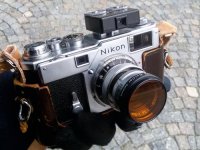Tveljus
Established
Hi everyone, I've been enjoying my minty fresh Micro-Nikkor·C 5cm f3.5 (s-mount) with an EP-marking on the barrel for these few months I've had it. But I keep reading about using the Micro-Nikkor collapsed for close-focusing, and I just can't wrap my head around it. How is it supposed to be used when collapsed? Doesn't collapsing the lens push focusing beyond infinity? I get that the special aperture collar must mean the lens can be used collapsed and un-reversed (I guess?). Can anyone clarify this?
So far I've used it on both my Nikon rangefinders and via Amedeo adapter on my Sony A7. Uncollapsed the lens focuses and works like a charm. I'm sorry if I've missed something obvious, but hitting this brick wall won't make me any smarter hehe.

So far I've used it on both my Nikon rangefinders and via Amedeo adapter on my Sony A7. Uncollapsed the lens focuses and works like a charm. I'm sorry if I've missed something obvious, but hitting this brick wall won't make me any smarter hehe.




